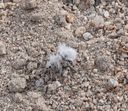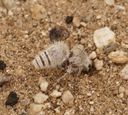Thistledown Velvet Ant
Dasymutilla gloriosa
Classification
- Phylum: Arthropoda
- Subphylum: Hexapoda
- Class: Insecta
- Order: Hymenoptera
- Superfamily: Pompiloidea
- Family: Mutillidae
- Subfamily: Sphaeropthalminae
- Tribe: Dasymutillini
- Genus: Dasymutilla
- Species: gloriosa
Pronunciation
How to pronounce Dasymutilla gloriosa: /ˌdæsɪmjuˈtɪlə ɡloʊˈriːəsə/
These audio files are automatically generated. While they are not always 100% accurate, they are a good starting point.
Images






Summary
Dasymutilla gloriosa, or thistledown velvet ant, is a wingless female member of the mutillid family, known for its painful sting and camouflage resembling Creosote bush seeds. It inhabits desert areas in the southwestern United States and Mexico.
Physical Characteristics
Body length 13-16 mm, black-red in color, covered by long white hair in wingless females.
Identification Tips
Females resemble a tuft of down or creosote seeds, with a somewhat red-tinged integument compared to Dasymutilla pseudopappus, and less erect setae on the head and thorax.
Habitat
Deserts or near-deserts.
Distribution
Southwestern United States (TX, NV, CA) and south into Mexico; common in Texas.
Diet
Larvae feed on the larvae of sand-wasps and the food provided by adult wasps within their burrows.
Life Cycle
Females lay eggs in the burrows of sand-wasps such as Bembix; pupation occurs in the larval chambers of the host.
Reproduction
Eggs are laid in the burrows of sand-wasps, where larvae develop and feed on host larvae.
Ecosystem Role
Plays a role as a parasite of sand-wasp larvae, impacting their populations.
Health Concerns
Females can deliver a very painful sting as a defense mechanism.
Evolution
Coloration primarily adapted to hot desert conditions, with some aposematic coloration characteristics.
Misconceptions
Females were once thought to mimic the seeds of the Creosote bush, but their coloring is primarily adaptive to environmental conditions rather than predation.
Tags
- Dasymutilla gloriosa
- thistledown velvet ant
- southwestern US
- desert insects
- Hymenoptera
- mutillidae